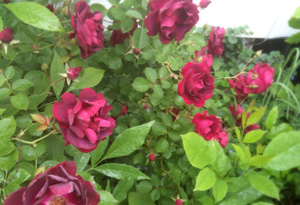In the Weeds

Photo: Simran Sethi
No matter the season, if it's morning, you can find environmental journalist Simran Sethi standing the middle of her garden outside her Kansas home, taking it all in.
Every morning, I wake up, make coffee, throw on a robe or coat, slide on shoes and head out into my yard to survey the terrain. Those early, quiet moments are sacred. I reflect on dreams, ponder challenges and, in my head, start to assemble my day. During colder months, I would stand relatively still and stay close to the house, hugging the steaming mug of coffee to my chest and trying not to get too cold. Now, in this first spring-into-summer in my new home, I traverse the expanse of the double lot, eager to see what the yard will reveal, into what color the turgid buds will bloom.This is an unaccustomed state of observation. I am used to thinking and moving quickly. Yet I am patient under the honeysuckles. I watch in silence as the bunnies sprint across the yard. I pay close attention to the bulbs that open and, ultimately, close.
I do not yet know how to interact with this garden. I have no idea how to tame the weeds or harness the flowers. Mowing, weeding and staking are unfamiliar. While my neighbors maintain sweetly manicured lawns, mine is—save for the few neat rows of kale and tomatoes grown by my yardshare companion, Mason—large and messy.
In her book Gardening for a Lifetime: How to Garden Wiser as You Grow Older, Sydney Eddison explains the ways in which she's grown with her garden and how it's played an intimate role in her life. "It has witnessed my greatest joys and absorbed my deepest sorrows," she writes. "It is a place of safety and comfort, an old forgiving friend who is always there for me, who protects and embraces me." Eddison has helped me understand that there are a number of ways of engaging with this touchstone of a garden.
For now, we are still feeling each other out. The yard is aware that I don't know an annual from a perennial, or English ivy from poison ivy. It seems content to do its thing and I, for the most part, feel the same. It knows I won't coddle it with water (I am adamant about encouraging drought-resistant varieties of plants that are appropriate for this climate) or choke it with pesticides (my fruits and vegetables are grown organically, and I want my whole yard to be free of toxic chemicals).
Eddison says, "Gardeners garden the way they do because of the people they are." This observational gardening—active in my head, passive in my hands—is revealing a new way of being to me. We are at the start of a long relationship, and I feel no urgency. There will be time to pull the weeds from the roses in years to come.
Simran
Simran Sethi is an award-winning journalist and associate professor at the University of Kansas School of Journalism and Mass Communications. For more information on Sethi, visit SimranSethi.com and follow her on Twitter @simransethi.
Keep Reading:
What's your gardening style? Take this quiz to find out!
10 tips for new gardeners
Why you should make your garden organic



